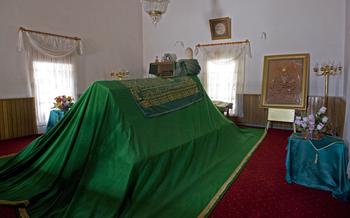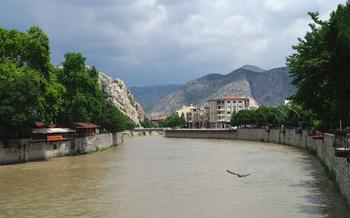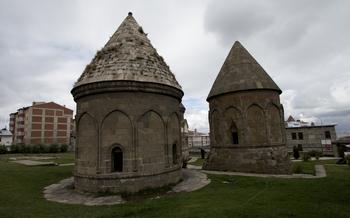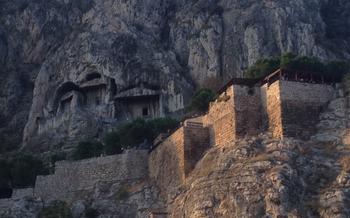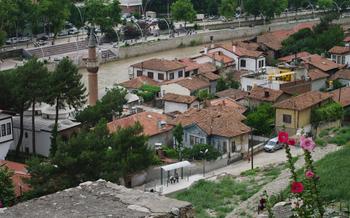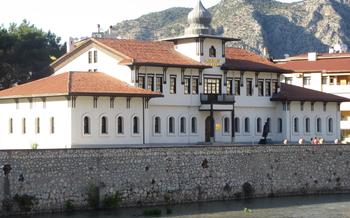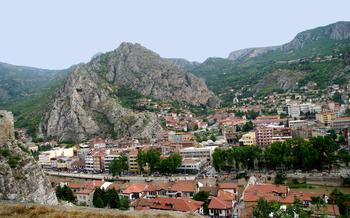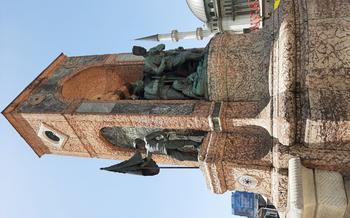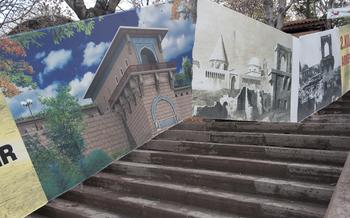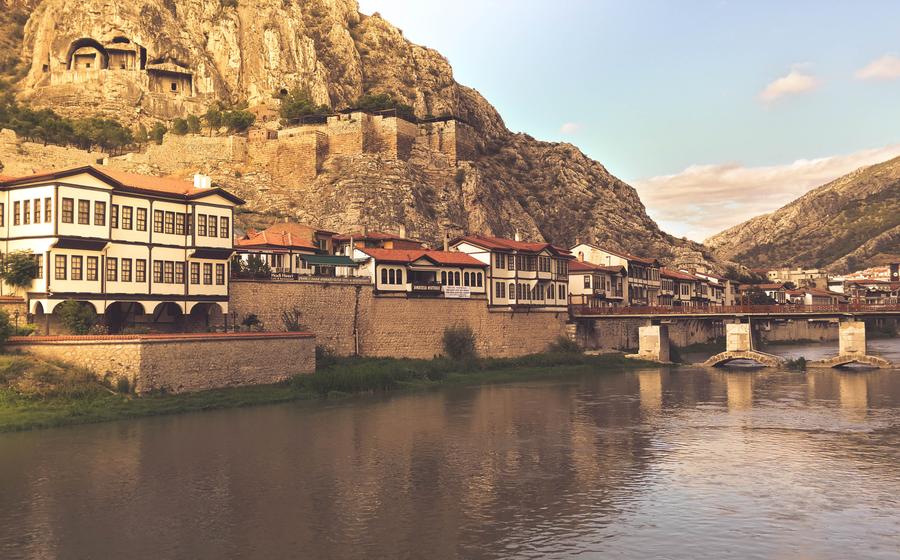
Amasya Nizamülmülk Mosque
- Amasya Nizamülmülk Mosque: A Historical and Architectural Masterpiece
- Location and Accessibility: Finding Your Way to the Mosque
- Hours of Operation and Entrance Fees: Planning Your Visit
- Marvelous Interior: Exploring the Mosque's Design
- Historical Figures and Legends: Unveiling the Mosque's Past
- Cultural Significance: The Mosque as a Symbol of Community
- Restoration and Preservation: Safeguarding the Mosque's Heritage
- Prayer and Spirituality: A Place of Worship and Reflection
- Educational and Cultural Programs: Expanding Knowledge and Understanding
- Local Cuisine: A Taste of Amasya's Flavors
- Souvenirs and Handicrafts: Taking Home a Piece of Amasya
- Photography and Visual Exploration: Capturing the Mosque's Beauty
- Accessibility for Visitors with Disabilities: Ensuring Inclusivity
- Respectful Conduct: Guidelines for Visitors
- Insider Tip: Hidden Gem and Secret Spots
Amasya Nizamülmülk Mosque: A Historical and Architectural Masterpiece
Amidst the picturesque landscapes and rich cultural heritage of Amasya, the Nizamülmülk Mosque stands as a testament to the city's architectural prowess and religious devotion. Built in the 12th century during the Seljuk era, this magnificent mosque bears the name of Nizamülmülk, a prominent statesman and scholar who served as the vizier of the Seljuk Empire. The mosque's historical significance is deeply intertwined with the city's past, serving as a symbol of Amasya's architectural achievements and its role as a center of Islamic learning and culture.
The mosque's architectural design showcases a harmonious blend of Seljuk and Anatolian styles, characterized by its intricate stonework, elegant arches, and a striking dome that dominates the skyline. The interior of the mosque exudes an atmosphere of serenity and grandeur, with its vast prayer hall adorned with exquisite calligraphy, intricate tilework, and decorative motifs. The Amasya Nizamülmülk Mosque stands as a testament to the enduring legacy of Islamic architecture, reflecting the artistic, cultural, and religious heritage of Amasya and its people.
Location and Accessibility: Finding Your Way to the Mosque
The Amasya Nizamülmülk Mosque stands tall in the heart of Amasya, a city steeped in history and natural beauty. Reaching the mosque is a breeze, whether you choose to navigate the charming streets on foot or utilize the convenient public transportation options.
For those arriving by car, there are ample parking spaces available in the vicinity of the mosque. Simply follow the signs or ask locals for directions, and you'll be guided to the nearest parking area.
Visitors with disabilities will find the mosque easily accessible, as ramps and elevators have been thoughtfully incorporated to ensure inclusivity. Designated seating areas and prayer spaces are also available to accommodate individuals with special needs.
To enhance your exploration of the mosque and its surroundings, consider visiting some of the nearby landmarks and attractions. The Amasya Museum, with its rich collection of artifacts, offers a glimpse into the city's fascinating past. The scenic Yeşilırmak River, flowing gracefully through the city, provides a tranquil backdrop for a leisurely stroll or boat ride.
No matter your mode of transportation or your level of mobility, discovering the Amasya Nizamülmülk Mosque is a rewarding experience that awaits you.
Hours of Operation and Entrance Fees: Planning Your Visit
The Amasya Nizamülmülk Mosque welcomes visitors during specific hours to ensure the sanctity of religious practices and maintain a peaceful atmosphere. To plan your visit effectively, here's what you need to know:
-
Opening Hours: The mosque is generally open to visitors from 9:00 AM to 5:00 PM daily. However, it's important to note that during prayer times, which occur five times a day, the mosque may be closed to visitors for a short period. It's advisable to check the mosque's official website or contact local tourism authorities for the most up-to-date information on opening hours.
-
Entrance Fees: Admission to the Amasya Nizamülmülk Mosque is free of charge for all visitors. This reflects the mosque's commitment to providing access to its architectural and cultural treasures without financial barriers.
-
Recommended Visit Times: For a more serene and contemplative experience, it's recommended to visit the mosque outside of prayer times. During these periods, the mosque is typically less crowded, allowing you to fully appreciate its tranquility and immerse yourself in its spiritual atmosphere.
-
Checking for Special Events or Closures: Before your visit, it's advisable to check for any special events or closures that may affect the mosque's accessibility. Occasionally, the mosque may host religious ceremonies, festivals, or restoration work that could temporarily restrict visitor access. By staying informed about potential closures, you can avoid any inconvenience and make the most of your visit.
Marvelous Interior: Exploring the Mosque's Design
The interior of the Amasya Nizamülmülk Mosque is a testament to the exquisite craftsmanship and artistic vision of its creators. The vast prayer hall, with its soaring dome and elegant arches, creates a sense of awe and tranquility. The walls are adorned with intricate tilework and calligraphy, showcasing verses from the Quran and patterns inspired by Islamic art. The intricate details and ornamentation, including carved wood panels and stained-glass windows, further enhance the mosque's visual splendor.
The highlight of the mosque's interior is its grand dome, which dominates the skyline and is visible from afar. Supported by massive pillars, the dome features intricate geometric patterns and colorful mosaics that create a mesmerizing effect. The natural light filtering through the windows illuminates the interior, casting a warm glow on the intricate designs and enhancing the overall ambiance of the mosque.
Historical Figures and Legends: Unveiling the Mosque's Past
The Amasya Nizamülmülk Mosque holds within its walls a treasure trove of stories and legends that have shaped its history and significance. One tale recounts the visit of the renowned traveler and scholar, Ibn Battuta, who marveled at the mosque's architectural splendor during his journey through Anatolia. According to local lore, the mosque's construction was overseen by a pious and skilled architect named Mimar Sinan, who is also credited with designing several other iconic Ottoman structures.
Another legend tells of a hidden chamber beneath the mosque, said to contain a secret well that miraculously appeared during a severe drought. The well's water is believed to possess healing properties, and pilgrims would often come from far and wide to seek its blessings. These stories and legends add a layer of mystique and enchantment to the mosque, making it a place of not only architectural beauty but also historical and cultural intrigue.
Cultural Significance: The Mosque as a Symbol of Community
The Amasya Nizamülmülk Mosque stands as a symbol of unity and identity for the local community. It serves as a central gathering place for religious rituals, celebrations, and community events. The mosque fosters a sense of belonging and togetherness among the residents, who come together to share their faith, culture, and traditions.
During religious festivals and holidays, the mosque becomes a hub of activity, filled with worshippers, families, and friends. Special prayers, sermons, and communal meals are held, strengthening the bonds of community and reinforcing the mosque's role as a spiritual and social center.
The mosque also plays a crucial role in promoting cultural exchange and understanding. It welcomes visitors from diverse backgrounds, providing a platform for interfaith dialogue and fostering respect for different cultures and beliefs. Through educational programs and events, the mosque encourages visitors to learn about Islamic history, architecture, and practices, fostering a deeper appreciation for the rich cultural heritage of the region.
Restoration and Preservation: Safeguarding the Mosque's Heritage
The Amasya Nizamülmülk Mosque has undergone meticulous restoration and preservation efforts to maintain its historical integrity. The local community and government have played crucial roles in safeguarding the mosque's heritage, working together to ensure its preservation for future generations.
One of the main challenges faced in preserving the mosque was the need to balance restoration with maintaining its original character. Experts carefully analyzed the mosque's architectural features, materials, and decorative elements to ensure that any restoration work was carried out with precision and respect. Traditional techniques and materials were employed to stay true to the mosque's historic construction methods.
Success stories in preserving the mosque's heritage include the restoration of its intricate tilework and calligraphy. Skilled artisans painstakingly restored damaged tiles and inscriptions, bringing back their original vibrancy and beauty. The mosque'sโดม, a prominent feature, was also carefully repaired and reinforced to maintain its structural integrity.
Through these tireless efforts, the Amasya Nizamülmülk Mosque stands as a testament to the enduring spirit of preservation. Its restored splendor allows visitors to appreciate the mosque's historical significance and architectural beauty, ensuring that this cultural treasure continues to inspire and captivate generations to come.
Prayer and Spirituality: A Place of Worship and Reflection
The Amasya Nizamülmülk Mosque stands as a sanctuary for spiritual seekers, a place where the faithful gather to connect with the divine and find solace in prayer. As a functioning house of worship, the mosque exudes an aura of tranquility and reverence that invites visitors to immerse themselves in its sacred atmosphere.
For Muslims, the mosque holds immense significance as a place to fulfill their religious obligations. The main prayer hall, with its rows of intricately patterned carpets, provides a communal space for worshippers to come together and perform their daily prayers. The acoustics of the hall amplify the recitation of verses from the Quran, creating a mesmerizing symphony of faith.
Beyond its role as a place of prayer, the mosque also serves as a center for spiritual reflection and contemplation. Visitors are encouraged to take a moment of quiet introspection, to connect with their inner selves and seek guidance and peace amidst the serene surroundings. The mosque's tranquil ambiance fosters a sense of mindfulness and spiritual growth, making it an ideal destination for those seeking a deeper connection with their faith.
It is important to note that while the mosque welcomes visitors from all backgrounds, certain customs and etiquette should be observed to ensure a respectful and harmonious environment. Modest dress is recommended, and visitors should be mindful of maintaining silence and avoiding distractions during prayer times. By adhering to these guidelines, visitors can contribute to the sanctity of the mosque and enhance their own spiritual experience.
Educational and Cultural Programs: Expanding Knowledge and Understanding
The Amasya Nizamülmülk Mosque serves as a vibrant hub for educational and cultural programs, fostering a deeper understanding of Islamic history, culture, and architecture. Visitors can participate in workshops, lectures, and exhibitions that delve into the mosque's rich heritage and significance. These programs provide a platform for dialogue, promoting interfaith understanding and appreciation.
One notable initiative is the "Discover Islamic Architecture" workshop, where participants learn about the mosque's unique design elements and their symbolic meanings. Through hands-on activities, they explore the significance of domes, arches, and calligraphy, gaining insights into the mosque's architectural legacy.
Another popular program is the "Sufi Nights" lecture series, which explores the mystical traditions and teachings of Sufism. Renowned scholars and practitioners share their knowledge, providing attendees with a deeper understanding of Islamic spirituality and its profound impact on Turkish culture.
To foster interfaith dialogue, the mosque hosts regular events that bring together people from diverse religious backgrounds. These gatherings promote open discussions, allowing participants to share their perspectives and experiences, fostering mutual respect and understanding.
The mosque's educational programs have garnered widespread acclaim, attracting visitors from around the world. Participants often express their gratitude for the opportunity to learn and engage in meaningful dialogue, creating lasting memories and fostering a greater appreciation for Islamic culture.
Local Cuisine: A Taste of Amasya's Flavors
A visit to the Amasya Nizamülmülk Mosque is not complete without sampling the local cuisine of Amasya. The city is renowned for its rich culinary traditions, blending Turkish and regional flavors.
After exploring the mosque, take a stroll through the charming streets and discover local restaurants or cafes that offer traditional dishes and specialties. Indulge in the flavors of "Amasya Çöreği," a sweet pastry filled with walnuts and poppy seeds. Sample the "Amasya Elması," a unique variety of apple known for its sweetness and crunch.
For a taste of local delicacies, try the "Amasya Mantısı," small dumplings filled with meat or cheese, served with yogurt sauce and garlic. The "Amasya Kebabı," made with tender lamb or beef grilled on skewers, is another must-try dish.
Vegetarians and vegans will find plenty of options in Amasya. Try the "Amasya Dolması," a variety of stuffed vegetables such as peppers, tomatoes, and zucchini, prepared with rice, herbs, and spices. The "Amasya Pilavı," a fragrant rice dish with chickpeas, currants, and pine nuts, is another delicious option.
When in Amasya, don't miss the opportunity to savor the local flavors. Whether you prefer traditional Turkish cuisine or lighter vegetarian options, you'll find something to delight your taste buds.
Souvenirs and Handicrafts: Taking Home a Piece of Amasya
Your journey to Amasya would be incomplete without taking home a souvenir to cherish the memories of your visit to the Amasya Nizamülmülk Mosque. In the vicinity of the mosque, you'll find an array of shops and stalls offering a treasure trove of local handicrafts and artisanal products.
Look out for intricately handwoven carpets and kilims, each thread telling a story of Anatolian craftsmanship. These vibrant textiles, with their rich colors and intricate patterns, make for a beautiful and practical souvenir.
Discover the art of Turkish ceramics in the form of hand-painted bowls, plates, and vases. These colorful creations, adorned with intricate designs and motifs, are a delightful reminder of Amasya's artistic heritage.
For those seeking unique and meaningful souvenirs, consider purchasing a piece of locally crafted jewelry. From delicate silver filigree to vibrant gemstones, these adornments showcase the skill and artistry of local artisans.
Bargaining is a customary part of shopping in Turkey, so don't hesitate to engage in friendly negotiations to secure the best prices. Remember, the experience of haggling is as much a part of the cultural exchange as the purchase itself.
Whether you choose a handwoven textile, a ceramic masterpiece, or a piece of exquisite jewelry, your souvenir from the Amasya Nizamülmülk Mosque will serve as a tangible reminder of the beauty and cultural richness you encountered during your visit.
Photography and Visual Exploration: Capturing the Mosque's Beauty
The Amasya Nizamülmülk Mosque, with its architectural splendor and serene atmosphere, presents an irresistible opportunity for photography enthusiasts. To capture the essence of this magnificent structure, here are some guidelines and tips:
-
Respectful Approach: Always seek permission before taking photographs, especially if worshippers are present. Be mindful of their privacy and avoid disturbing ongoing prayers or rituals.
-
Appropriate Attire: Dress modestly and respectfully when visiting the mosque. Avoid wearing shorts, tank tops, or revealing clothing.
-
Silent Mode: Ensure your camera is set to silent mode to minimize disruptions during prayers or contemplation.
-
Composition and Lighting: The mosque's intricate details and expansive interiors offer endless photographic possibilities. Experiment with different angles and lighting conditions to capture the best shots.
-
Tripods and Equipment: If using a tripod or other photography equipment, be considerate of other visitors and avoid obstructing pathways or blocking their views.
-
Social Media Sharing: If sharing your photos online, be sure to tag the mosque or use relevant hashtags to connect with other enthusiasts and share your experiences with the world.
Remember, the Amasya Nizamülmülk Mosque is a sacred space, and capturing its beauty should be done with respect and reverence.
Accessibility for Visitors with Disabilities: Ensuring Inclusivity
The Amasya Nizamülmülk Mosque is committed to providing an accessible and welcoming environment for visitors with disabilities. The mosque features wheelchair-accessible ramps and elevators, ensuring that all levels of the building are accessible to those with mobility impairments. Designated seating areas and prayer spaces are also available within the mosque to accommodate individuals with disabilities.
For those who require assistance or accommodations, the mosque's staff is available to provide support. Visitors are encouraged to reach out to the mosque's administration in advance to request any specific assistance or accommodations they may need. The mosque's staff is dedicated to ensuring that all visitors, regardless of their abilities, have a fulfilling and meaningful experience at the Amasya Nizamülmülk Mosque.
Respectful Conduct: Guidelines for Visitors
When visiting the Amasya Nizamülmülk Mosque, it is essential to adhere to the principles of respectful conduct and mindful behavior. As a sacred space for worship and reflection, the mosque demands a level of courtesy and reverence from all visitors.
Upon entering the mosque, visitors are expected to dress appropriately, avoiding revealing or disrespectful clothing. Modest attire that covers the shoulders and knees is recommended for both men and women. Additionally, it is customary to remove footwear before entering the prayer hall, as a sign of respect for the sanctity of the space.
Once inside, maintaining silence and minimizing distractions is crucial. Conversations and loud noises should be kept to a minimum, allowing worshippers to focus on their prayers and devotions. Visitors should also avoid walking in front of people who are praying, as this may disrupt their concentration.
When interacting with worshippers or mosque officials, it is essential to be polite and respectful. Greetings should be offered in a friendly and courteous manner, and any questions or inquiries should be made in a discreet and considerate way.
By observing these guidelines for respectful conduct, visitors can contribute to the peaceful and harmonious atmosphere of the Amasya Nizamülmülk Mosque, ensuring that everyone can experience the spiritual significance and beauty of this sacred space.
Insider Tip: Hidden Gem and Secret Spots
Beyond the main prayer hall, the Amasya Nizamülmülk Mosque holds hidden gems and secret spots that offer a unique experience to visitors. One such gem is the tranquil courtyard, adorned with lush greenery and a serene fountain. Here, you can find a moment of peace and reflection, away from the hustle and bustle of the city.
For those interested in history and architecture, the mosque's minaret offers breathtaking panoramic views of Amasya. Climb the narrow spiral staircase to the top, and you'll be rewarded with stunning vistas of the city's landmarks, including the meandering Yeşilırmak River and the ancient rock tombs.
If you're looking to explore beyond the mosque, venture into the surrounding neighborhood. Just a short walk away, you'll find charming cafes and shops where you can savor local delicacies and pick up unique souvenirs. Don't miss the opportunity to stroll along the riverbank, where you can witness the vibrant energy of the city and capture picturesque views of the mosque from a different perspective.
Remember, these hidden gems and secret spots are best discovered by embracing the spirit of exploration and immersing yourself in the local culture. Ask questions, engage with the locals, and be open to unexpected encounters – they might just lead you to unforgettable experiences that will make your visit to the Amasya Nizamülmülk Mosque truly memorable.
